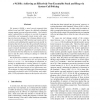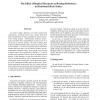832 search results - page 17 / 167 » Effect of Malicious Synchronization |
ACSAC
2005
IEEE
14 years 3 months ago
2005
IEEE
We present e-NeXSh, a novel security approach that utilises kernel and LIBC support for efficiently defending systems against process-subversion attacks. Such attacks exploit vul...
ATAL
2006
Springer
13 years 11 months ago
2006
Springer
We study the problem of agents attempting to find quality service providers in a distributed environment. While referrals from other agents can be used to locate high-quality prov...
CSSE
2008
IEEE
13 years 11 months ago
2008
IEEE
Both teaching and learning multithreaded ing are complex tasks, due to the abstraction of the concepts, the non-determinism of the scheduler, the impossibility of using classical s...
ASPLOS
2011
ACM
13 years 1 months ago
2011
ACM
Transactional memory (TM) is a promising synchronization mechanism for the next generation of multicore processors. Best-effort Hardware Transactional Memory (HTM) designs, such a...
P2P
2006
IEEE
14 years 3 months ago
2006
IEEE
To achieve higher efficiency over their unstructured counterparts, structured peer-to-peer systems hold each node responsible for serving a specified set of keys and correctly r...


